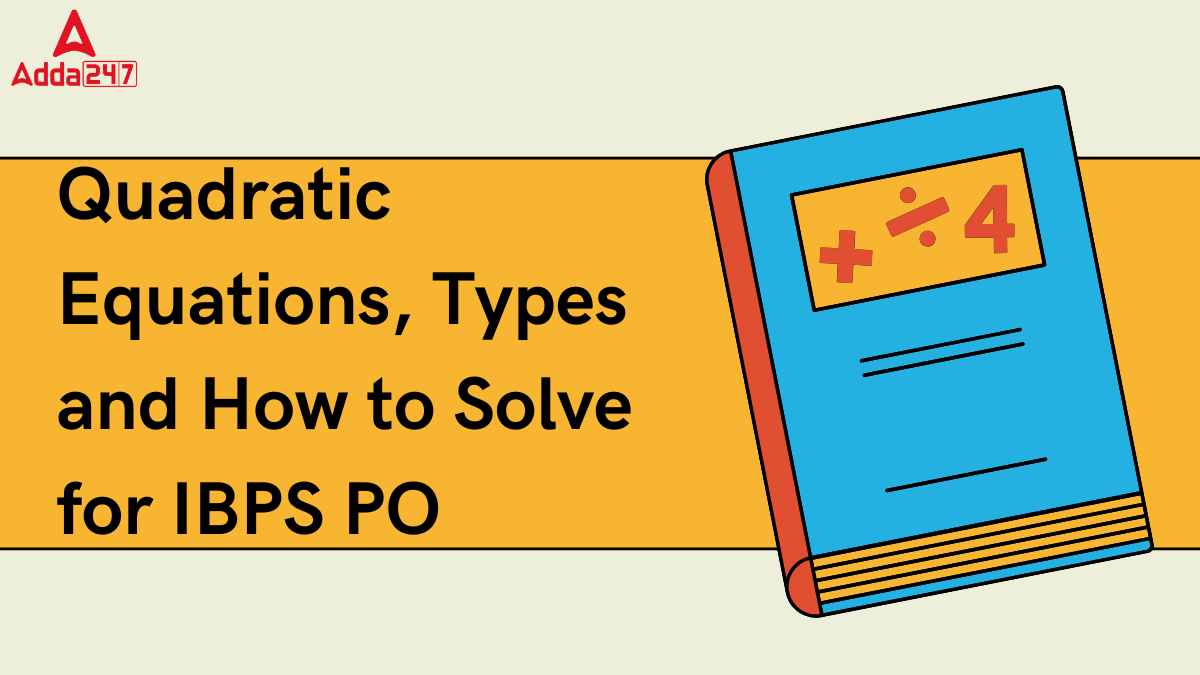Quadratic equations are a vital part of the Quantitative Aptitude section in the IBPS PO 2025 exam. Questions on this topic are frequently asked and often come with high scoring potential. Understanding the basics, types of equations, and methods of solving them is crucial for candidates preparing for this competitive exam. With a solid grasp of concepts and quick calculation skills, aspirants can easily solve quadratic problems within seconds during the test.
Quadratic Equations for IBPS PO 2025
A quadratic equation is an equation of the form ax² + bx + c = 0, where a, b, and c are real numbers and a ≠ 0. It represents a polynomial equation of degree two, and its solutions (or roots) are the values of x that satisfy the equation. In the IBPS PO exam, these equations usually appear in the form of a pair of quadratic equations, where a candidate has to compare the values of x and y.
Types of Quadratic Equations
Understanding the types of quadratic equations helps in choosing the right solving strategy. Here are the common types:
1. Pure Quadratic Equations: These equations contain only the square term and a constant. Example: x² – 9 = 0
2. Quadratic Equations with All Terms: These include the x², x, and constant terms. Example: 2x² + 3x – 5 = 0
3. Factorable Quadratic Equations: Equations that can be easily factored into two binomial expressions. Example: x² – 7x + 12 = 0 → (x – 3)(x – 4) = 0
4. Equations with Irrational or Imaginary Roots: These are equations whose discriminant is negative, leading to complex roots. Example: x² + x + 1 = 0
How to Solve Quadratic Equations for IBPS PO
There are three primary methods used to solve quadratic equations in exams like IBPS PO:
1. Factorization Method
Split the middle term such that the product of the first and last term equals the product of the new terms. Example:
x² + 5x + 6 = 0
⇒ (x + 2)(x + 3) = 0
⇒ x = -2, -3
2. Using the Quadratic Formula
Use when factorization is not straightforward. The formula is:
x = [-b ± √(b² – 4ac)] / 2a
For example:
x² + 4x + 1 = 0
⇒ x = [-4 ± √(16 – 4)] / 2
⇒ x = [-4 ± √12] / 2
⇒ x = (-4 ± 2√3) / 2
⇒ x = -2 ± √3
3. Completing the Square
Rewriting the equation in the form (x + a)² = b. This method is used less in exams due to its longer steps, but it is helpful when required.
How Quadratic Equations Are Asked in IBPS PO
In the IBPS PO exam, you are often given two equations, one in x and another in y, and asked to compare x and y. The possible answer choices are:
x > y,
x < y,
x ≥ y,
x ≤ y,
x = y or
the relationship can’t be established
To solve such problems:
Solve both equations separately.
Find the roots.
Compare the roots systematically.
Example:
x² – 5x + 6 = 0 → x = 2, 3
y² – 7y + 10 = 0 → y = 2, 5
Compare each x with each y and conclude as per the question asked.
Quick Tips for IBPS PO Aspirants
Quadratic equations might appear complex, but with regular practice and a strategic approach, they can become a scoring area in IBPS PO 2025. Focus on mastering all three solving techniques and practice comparing roots, as it is commonly tested. Mastery of this topic can help you gain an edge in both speed and accuracy during the exam.
- Learn how to spot perfect squares and factor patterns quickly.
- Practice simplifying square roots mentally.
- Always check for common mistakes with signs and discriminants.
- Time yourself while solving mock questions to improve speed.





 Number Series Questions for Bank Exams
Number Series Questions for Bank Exams
 Most Important Approximation Questions f...
Most Important Approximation Questions f...
 Quadratic Equation Questions for SBI PO ...
Quadratic Equation Questions for SBI PO ...








